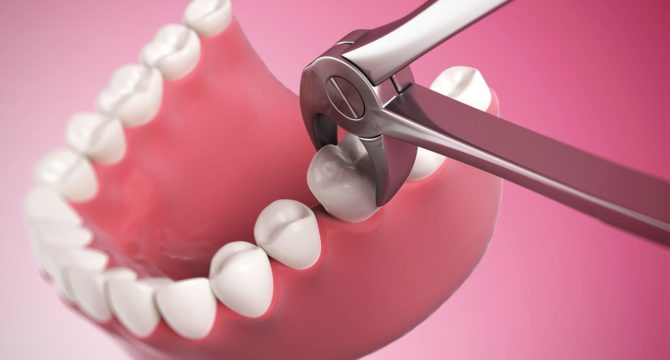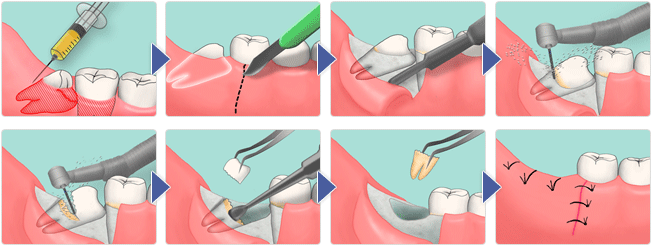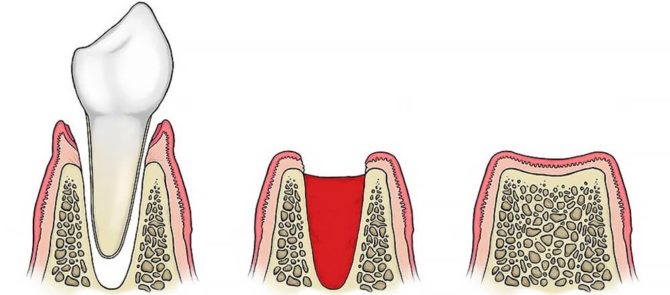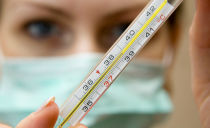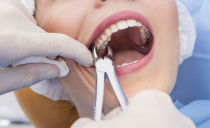Tooth extraction: indications, contraindications, procedure steps, possible complications
Tooth extraction is the most common surgery in dentistry. Despite significant progress in conservative dentistry, their removal occupies 90% of all operations performed in a dental clinic. Remaining a source of chronic infection, a bad tooth may not manifest itself at all. But with a decrease in immunity, dental diseases worsen, and then their removal may be required.
Content
Indications for extraction
Indications for tooth extraction are urgent (urgent) and planned:
| Urgent evidence | Planned Indications |
|---|---|
|
|
Contraindications for tooth extraction
There are no absolute contraindications to tooth extraction. That is, there are no conditions in which the tooth cannot be removed in any case, otherwise this will inevitably lead to a deterioration in the patient’s health. But for some diseases, it is better to postpone this procedure.
Relative contraindications include any acute conditions that require urgent therapeutic care:
- vascular disorders in the form of angina pectoris, stroke, heart attack;
- heart rhythm disturbance;
- chronic heart failure;
- renal failure;
- acute diseases of the kidneys, liver, blood;
- severe anemia;
- SARS, influenza, pneumonia.
In addition, teeth can not be pulled out in the 1st and 2nd trimester of pregnancy.
Stages of surgery and postoperative care
During the first visit to the patient, the dentist examines the tooth and determines whether it is loose, whether there is inflammation. If necessary, an x-ray is taken. If an indication for emergency extraction is detected, the dentist will perform the operation on the same day. If there is a planned indication, it will appoint the date of removal.
An adult or a small patient should be warned about the need to remove the tooth, about the approximate duration of the operation, about possible complications. The doctor should talk about the sensations that the patient will experience. Before surgery, people who are too emotional may be offered sedatives.
During extraction, local anesthesia with lidocaine, trimecaine or ultracaine is used, so pain does not occur. The patient can feel only slight discomfort and hear a characteristic crunch.
Tooth extraction consists of four stages:
- Overlay tool - forceps.
- Closing forceps.
- Tooth dislocation.
- Extraction of the extracted tooth from the socket.
Complicated teeth, such as wisdom teeth with uneven roots, are removed differently. During the extraction, gum cutting, cutting the molar into several parts for alternate extraction, suturing may be required.
At the end of the operation, the doctor puts a gauze swab on the hole, which must be kept in the mouth for 7 minutes. A blood clot should form at the site of the torn tooth. It is necessary so that saliva and microorganisms from the oral cavity do not enter the hole.
In no case should you remove the tampon earlier than the prescribed time and rinse your mouth for several days after extraction. The first action is fraught with prolonged bleeding and getting into the wound of the infection, the second - damage to the protective clot.
In the first two days after the procedure, you should not take too hot, hard and irritating food. After eating, instead of rinsing your mouth, you can do antiseptic baths (holding the solution in your mouth). Care should be taken when brushing your teeth so as not to damage the postoperative wound.
Wound healing terms
The wound is covered with epithelium for two to three weeks. If a tooth with one root has been removed, then healing of the gums will take 16–18 days. If the tooth had many roots, then the gum after its removal will heal in 19-23 days.
On the 14th day after removal, a loose soft tissue forms in the well, which replaces the blood clot. Then, bone beams appear along the edges of the holes; by the end of the 45th day, the hole is completely filled with finely looped spongy bone tissue. By the beginning of the fourth month, coarse-grained bone tissue is formed. By the sixth month, full bone tissue will be visible on the x-ray. In young people, healing is faster than in older people.
Possible complications
After tooth extraction, a variety of complications can develop - from bleeding to inflammation of the hole and the development of osteomyelitis - inflammation of the bone tissue of the jaw. Most often, the patient himself is to blame for the consequences, as he ignores the rules of postoperative oral care.
Bleeding
Such a complication as bleeding occurs in 0.25–0.5% of cases. Hole bleeding is divided into 3 degrees:
- 1 degree - the duration of bleeding over 20 minutes;
- 2 degree - the duration of bleeding over 40 minutes;
- Grade 3 - bleeding for 1 hour or more.
Classification of hole bleeding:
| Primary | Appears immediately after extraction of the extracted tooth. |
| Secondary | Appears after a few hours or days |
| Iatrogenic | Appears due to surgery |
| Idiopathic | Occurs spontaneously due to blood or vascular disease, with the destruction of tumors |
| Caused by local causes | In case of damage to blood vessels of bones and soft tissues surrounding the hole, as well as in the presence of a vascular tumor (intraosseous) |
| Caused by common causes | If the coagulation mechanism is violated: hemophilia, DIC |
If bleeding occurs, consult a doctor immediately. He will provide the patient with first aid and, if necessary, will suture the vessel or wound. After that, the doctor will prescribe local and general hemostatic agents to the patient: calcium chloride, dicinone, hemostatic sponge.
Alveolite
Alveolitis is an inflammatory process in the hole formed at the site of the extracted tooth. This complication is frequent in dentistry; it occurs in 24–35% of cases of tooth extraction. Often, the pathology manifests itself in children who have a permanent bite.
Alveolitis often develops on the lower jaw than on the upper. By seasonality: more often in March-April, less often - in December.
The main cause of alveolitis is neglect of hygiene rules, due to which the hole in the place of the extracted tooth is exposed to infection.
Typical manifestations:
- pain - constant or aching, worse with food;
- when a purulent infection is attached, it smells badly from the mouth, pus starts to stand out from the wound;
- weakness, malaise, headache;
- body temperature may rise.
In case of untimely access to a doctor, alveolitis can go from acute to chronic. The treatment of the disease consists in frequent washing of the oral cavity with an antiseptic solution and filling the hole with antibacterial paste, which the doctor will prescribe. In complex treatment, antibiotics, painkillers, anti-inflammatory drugs are used.
Modern dentistry has made significant progress. To date, the clinics in Moscow and other major cities use the most advanced technologies for the treatment and removal of teeth. Therefore, do not be afraid of dental procedures. You should often contact your dentist to receive quality and timely help.

